期待感を
高めて来てもらう
EATPIA
マ・プールがあるのは130ある東京メトロの駅の中で115番目という利用者数の少ない東大前の駅の近くなのですが、何故このエリアを選んだのでしょうか?
ソムリエールゆう子さん
東京の東側で育って、ようやく少しづつですが東側が盛り上がって来ているように感じていました。華やかなエリアではありませんが、山手線の内側で、タクシーでも来やすい場所だと思っています。
最初から飲食店が沢山あるような繁華街は考えてなかったんです。どちらかと言うと住宅街の中にポツンとあるようなイメージで、ここを目指して来てもらえるようになればと思っていました。
市岡徹也シェフ
そう。通りすがりの人が何か食べに入って来るのではなく、何を食べるのか期待して東大前まで来て欲しかったよね。
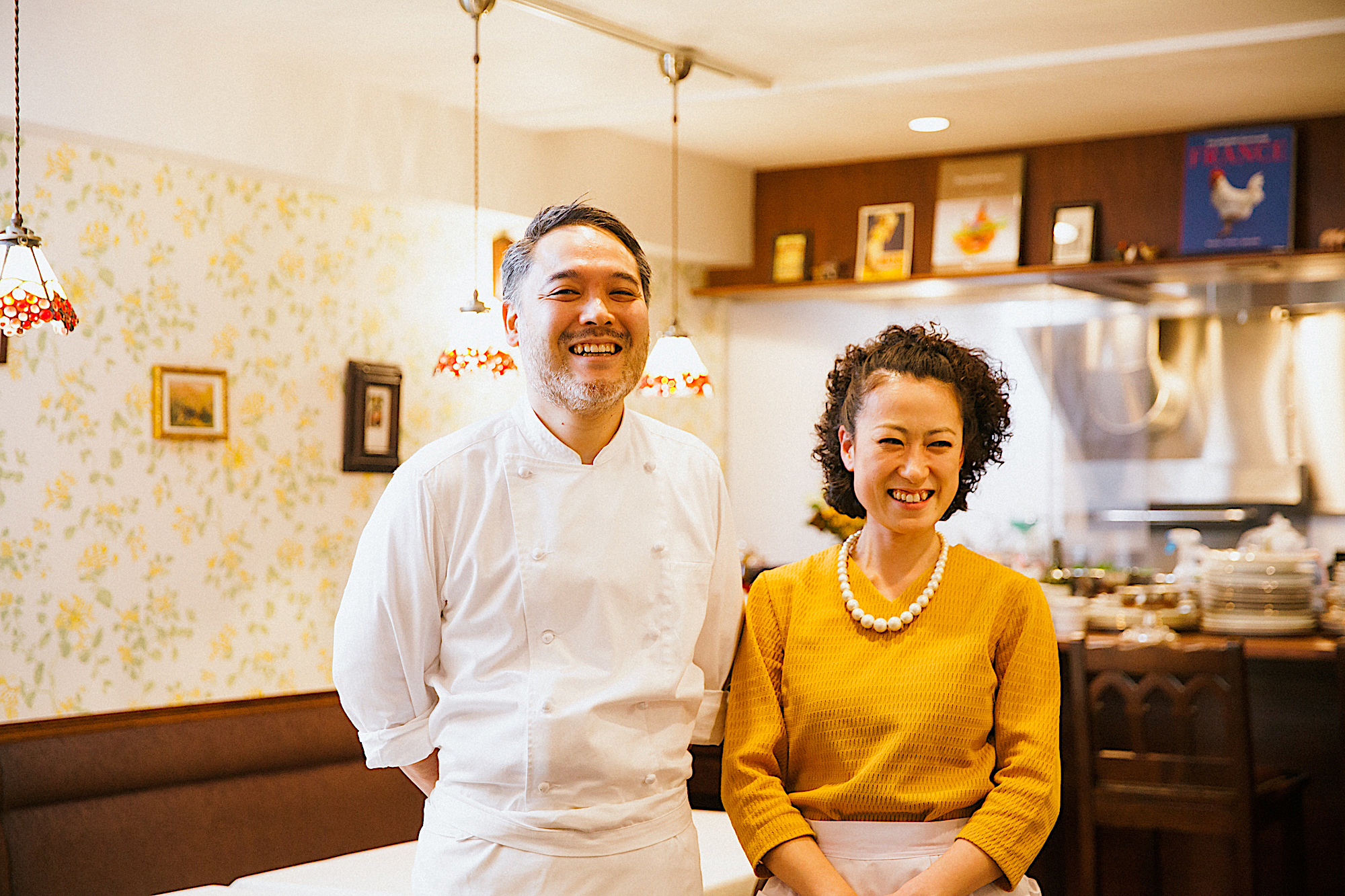
EATPIA
近所に住んでいる人の中にもフランス料理に造詣の深い方が多そうな印象があります。文教エリアといった感じで、谷中・根津・千駄木からも近く、落ち着いたエリアですよね。
ソムリエールゆう子さん
でも「初めて東大前の駅で降りました」と言う人は相変わらず多いんです。
市岡徹也シェフ
繁華街は嫌だったけど、具体的に東京の何処が良いかは深く考えてなかったよね。
ソムリエールゆう子さん
考えてました。例えば、駅からの距離だけではなく、歩きやすいかどうかを考えました。食事の後、落ち着いてディナーの余韻を感じながら駅まで歩けるか、カップルなら横並びで歩ける幅が歩道にあるか…そんな事を気にしました。
そう言えば初めて東大前に来た時に、銀杏の葉がきれいだったのと、昭和を思わせるようなノスタルジーを感じたのを思い出しました。
EATPIA
でも最初は東大前まで来てもらうのに苦労しませんでしたか?
市岡徹也シェフ
オープンしてから少しづつ雑誌、特に業界誌に取り上げてもらって、他のレストランのシェフやソムリエの人たちが来てくれたのが良かった。そこからジュラの料理とワインを味わえる店として評判になって、マニアックな食通の人たちが来てくれるようになったんです。
ソムリエールゆう子さん
そういった人たちがジュラの料理やワインを喜んでくれて、それから私たちも思い切ってジュラで行こうと思えるようになりました。それがなければ地元の人に受け入れてもらうために違ったスタイルの店になっていたと思います。
市岡徹也シェフ
もしも普通のフランス料理の店やっていたら今は無かったよね。
EATPIA
すっかり最初からジュラをコンセプトにしていたと思っていました。
市岡徹也シェフ
外観や内装のイメージはジュラだけど、食べてもらう料理に関してはジュラだけでなく、バスク、リヨン、ブルターニュでも働いてきたから、自分の今までの全ての経験を反映させたものを食べてもらおうと最初は思ってたんです。
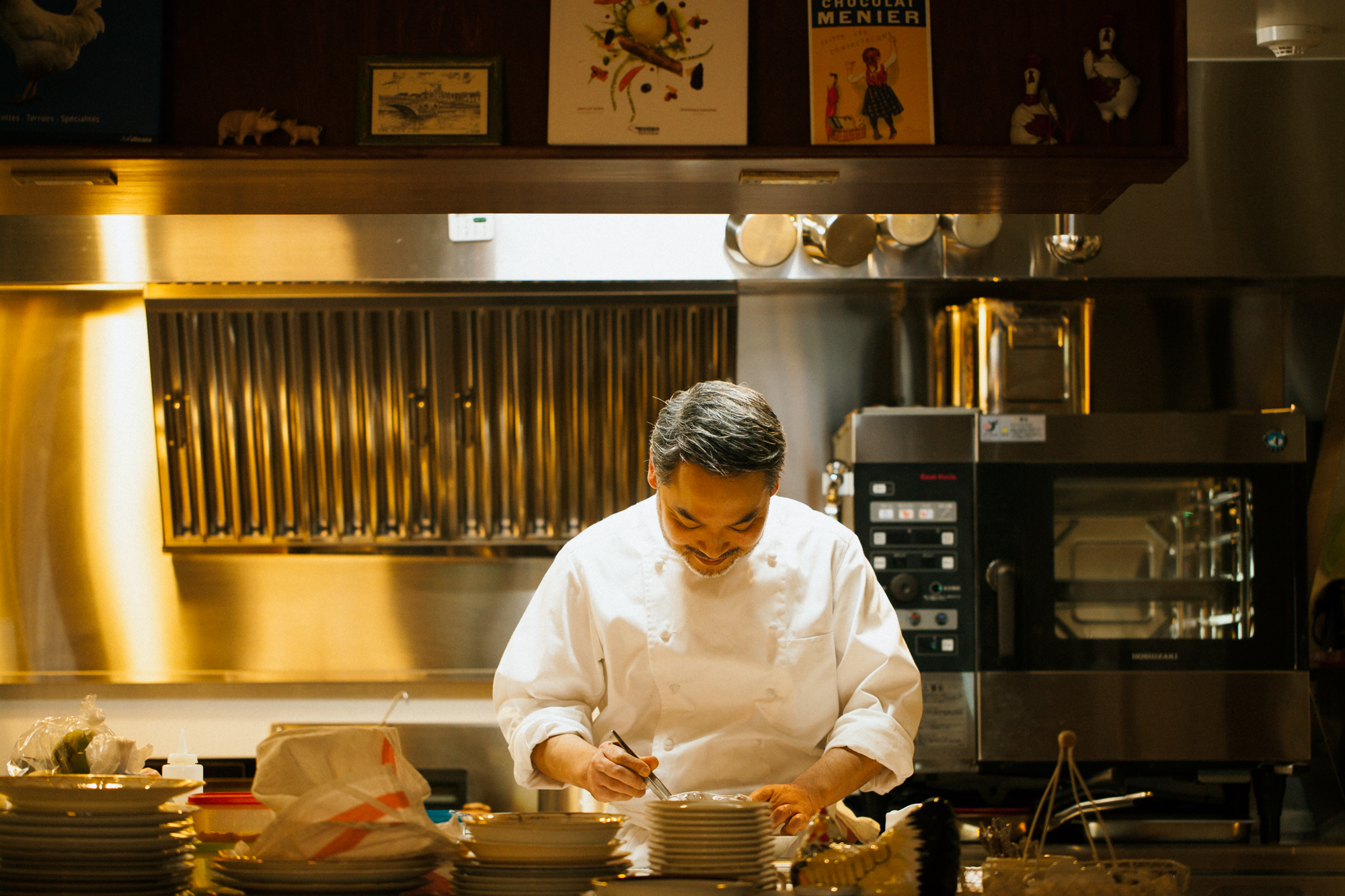
東京ではトゥール・ダルジャンにいたので、有名な「オレンジ・ソースのシャラン鴨の炭火焼」を自分なりに再現したものも食べてもらってました。
内側に秘めた
情熱を解き放つ
市岡徹也シェフ
幾つものレストランで働いてきたけど、その中でジュラのジャン・ポール・ジュネでの経験が一番強烈で、今でもジュラの料理には強い思い入れがあるんです。でも自分にとってジュラの料理は慣れ親しんだ当たり前のもので、そんなに凄いことをやっているという意識はなかった。今でも凄いとは思ってないです。
例えばジャン・ポール・ジュネでつくっていた「鶏とモリーユ茸のヴァンジョーヌ・ソース」は大好きな一皿で、最初からマ・プールでも出してたけど、ここまで評判になるとは思っていなかったんです。
食べてくれた人たちが驚いたり、喜んだりしてくれるのを見て、ジュラの料理には何か特別なものがあるのかも…と初めて思えるようになったんです。
だから最初の頃は小さめで出していた「鶏とモリーユ茸のヴァンジョーヌ・ソース」も、今はメインのポーションの大きいもの食べてもらってます。
ソムリエールゆう子さん
この「鶏とモリーユ茸のヴァンジョーヌ・ソース」は必ずジュラのワインに合わせて味わってもらっていたのですが、そのペアリングも評判になって、ジュラのワインを飲める店としても認知してもらえるようになりました。
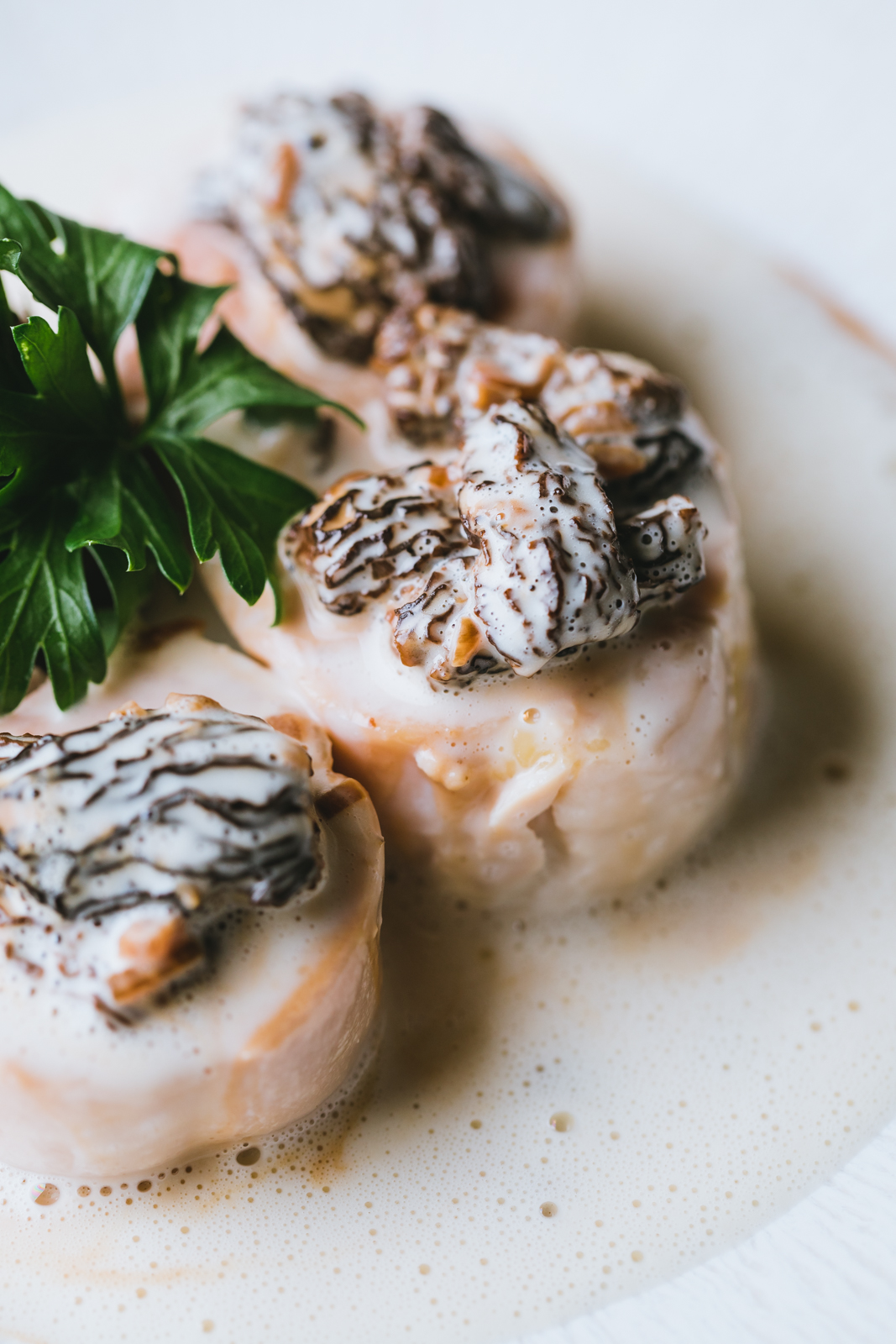
市岡徹也シェフ
それからは前菜などでもジュラ色を出した料理を食べてもらうようになって、自然とワインもチーズもジュラのものだけになったんです。
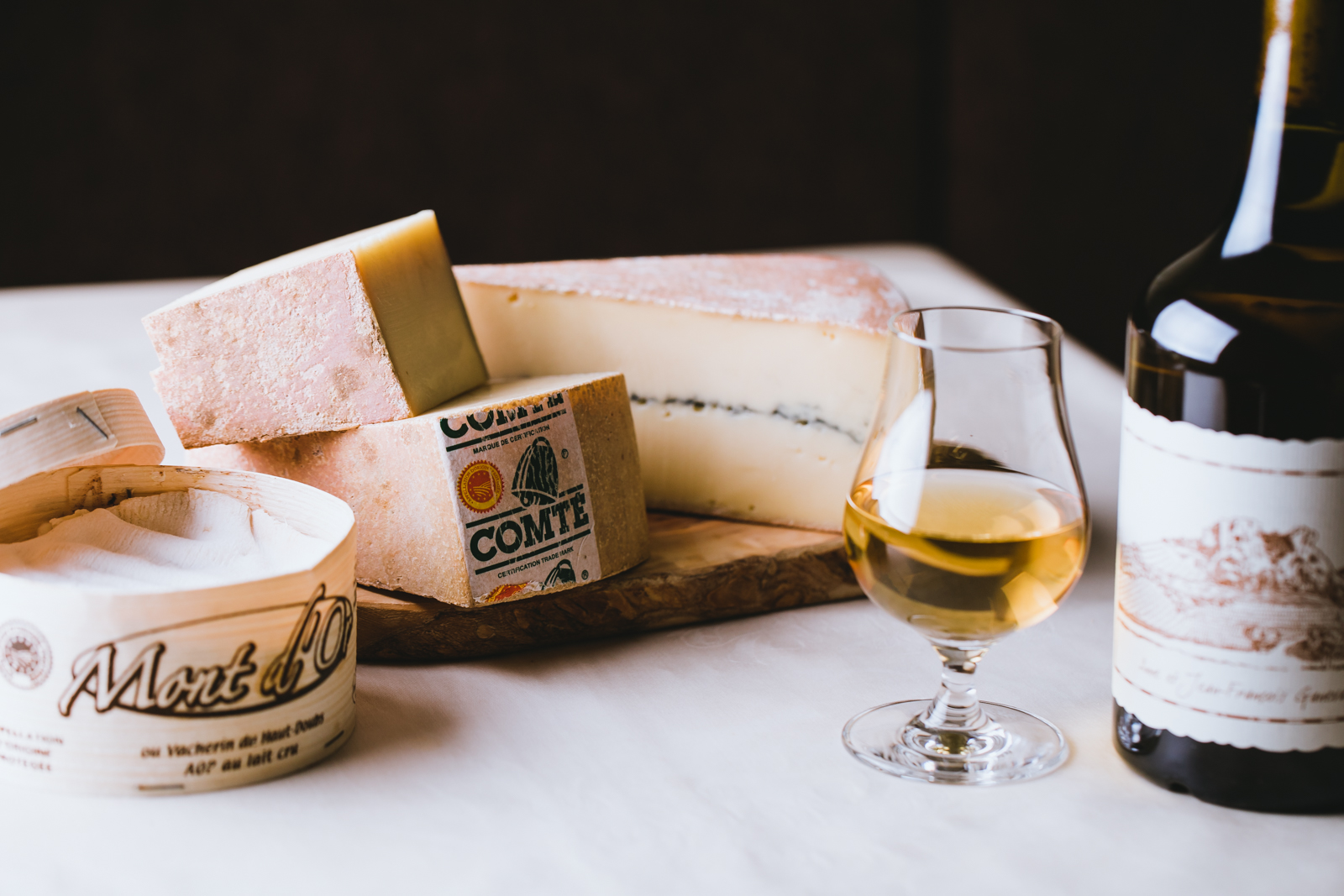
決して無理してジュラの料理やワインを前面に打ち出したわけでなく、食べに来てくれた人たちにリードされるような感じで、ジュラへの思いを自由に表現できるようになった…というか、内側にあった情熱を思い切り解放できるようになったんです。
EATPIA
今の東京でフランスの郷土料理をつくるということの背景には、どんな思いがあるのでしょうか?
市岡徹也シェフ
最初は時代に逆行してると思ってたけど、それでも流行りそうな洒落たフランス料理をやるつもりは全くなかった。つくれる料理をつくるのではなく、本当に自分でやりたい料理をやろうと決めてたんです。
やはり料理に大切なのは、高級な食材をつかったり、見栄えの良し悪しではなく、料理人の思いが込められているかどうかです。
そういった意味では、ジュラの料理は自分にとって一番思い入れのある料理だから、その思いを食べてくれる人も感じてくれたら嬉しいよね
ソムリエールゆう子さん
ワインも同じで、生産者の思いが感じられるものが美味しいワインだと思います。
市岡徹也シェフ
ワインも料理も、思いや、情熱といったものが詰まっていないのは薄っぺらくて、そんなモノの為に誰も東大前まで来ないよ。
フランスの
フランス料理
EATPIA
ジュラだけでなく、市岡シェフはフランスで合計9年近くも料理をしてきたのですが、その経験が具体的に役立っていると実感するようなことはありますか?
市岡徹也シェフ
日本人は料理の味わいを舌で感じるけど、フランス人は味を舌と上顎の両方で感じることに気づきました。上顎はフランス語でパレ(Palais)というのですが、フランス人はワインを味わう時に少し上を向くような感じで、顎を上て飲むことで、ワインが直接パレに当てるようにして味を感じてるみたいなんです。そうする事で味だけでなく鼻から抜けるワインの香りも楽しんでる。
日本人は香りと味を分けてとらえるけど、フランス人は一緒に楽しんでる。だから向こうではスパイスやハーブを積極的につかって料理する。特にジュラでは山の中にハーブがたくさんあるので、かなり使ってました。
ソムリエールゆう子さん
決してピリッとしたアクセントのためにスパイスを使っているわけではないので、食べている人との会話の中で、何種類ものスパイスやハーブが使われていることを話すと驚かれる人が多いです。
市岡徹也シェフ
キュイジーヌ・ロン (Cuisine Rond) という言葉があって、それを直訳すると丸い料理になります。丸い料理や、まろやかな料理と書くと日本語では個性がないとか、インパクトがないような感じになりますが、キュイジーヌ・ロンという言葉のニュアンスは丸の中に何種類もの味わいや香りがバランス良く共存しているといった感じです。特に何かが強く抜きん出ているわけでなく、何種類もの味わいや香りが重なり合って料理を味わい深いものにするんです。
このキュイジーヌ・ロンという考え方はフランスに行かなければ学べなかったと思うし、フランス人に食べてもらう為に料理してきたという経験は今とても役立っています。
空気を感じてもらう
EATPIA
5年間ブルゴーニュにあるレストランでも働いた経験があるのですが、本場フランスで、責任あるシェフとして働いた5年間は長かったですか、短かったですか?
市岡徹也シェフ
振り返ってみると短かかったようにも思えるけど、長かった…いろんな事があったから。でもシェフとして料理をしたり、食べに来てくれる人と話したりするのは楽しかった。
EATPIA
ブルゴーニュで5年間シェフと一緒にソムリエとして働いて何か記憶に残っていることはありますか?
ソムリエールゆう子さん
フランス人がレストランで食事をしながら、どうワインを味わうのか、どう会話を楽しむのか…とても感覚的なことなのですが、食事をしながらの時間の楽しみ方が日本人と違うことを肌で感じられたのは良かったです。
それがカップルでも家族でも、ただ飲みに行くのではなく、ただ食べに行くのでもなく…レストランでワインを飲みながら食事をして、会話を楽しむという時間に大きな価値を見出しているようでした。
休日には自分でも友人や、その家族と一緒に食事をしながら同じようなことを体験させてもらって、それが今のマ・プールの雰囲気づくりに無意識のうちにですが役立っていると思います。
EATPIA
マ・プールで食事をしていると時間がゆったりと流れているように錯覚することがあります。
市岡徹也シェフ
その為に具体的に何をやってるかは自分たちでも良く分からない。でも小さなレストランだから、この雰囲気を感じてもらえるんじゃないかな。これが少しでも大きなレストランだと薄まっちゃう。フランスにいた2人でやってるのが良いのかもしれないね。
ソムリエールゆう子さん
フランスで生活したことのある人や、フランス料理に精通している人から「日本じゃないみたい」「フランスにいるみたい」と言われることがあるのですが、やはりフランスでの経験が自然と役立っていると思います。
EATPIA
確かに、マ・プールで食事をしていると、他のテーブルにいる人たちがフランス料理が大好きで、フランスの文化にも造詣が深そうに見えたりします。
ソムリエールゆう子さん
ジュラの料理やワインについて調べてから食べに来る人が少なくありません。そして遠くから東大前まで来てくれる方もいます。最近は地元の人も食べに来てくれるようになりました。
市岡徹也シェフ
本気で食べに来てくれて、かなり期待されているように感じます。
原点回帰?
EATPIA
オープンして4年になりますが、フランス料理に関して何か変化してきたものはありますか?
ソムリエールゆう子さん
伝統的なフランス料理や郷土料理に興味をもっている若い料理人が増えているように思います。
市岡徹也シェフ
1人で食べに来る若い子が多いよね。そういった意味では原点回帰のようなものが起きているのかもしれないね。でも自信がなさそうというか、フランス料理をつくることを楽しんでなさそうな子が多いのが少し気になるね。
ソムリエールゆう子さん
料理人なんですか?フレンチの店で働いてるんですか?と質問をして「一応はフレンチなんですが、あれが本物のフランス料理なのか、よく分からないんです」みたいなことを言われたことがあります。
市岡徹也シェフ
それは寂しいよね。もしかしたらイノヴェーティブと呼ばれるような新しいタイプの料理をつくっているのかもしれないけど、志をもって突き進んでいけば、それはそれで素晴らしいものになるはずだよ。
これからの
フランス料理のあり方
EATPIA
これからの東京のフランス料理はどうなっていくのでしょうか?
市岡徹也シェフ
これからは2枚看板ですよ。イノヴェーティブと呼ばれるような新しい料理と伝統的な料理の両方がフレンチというカテゴリーを引っ張っていくことになるはずです。
ソムリエールゆう子さん
今までは伝統的な料理とイノヴェーティブな料理の両方が一括りでフランス料理として紹介されることが多かったのですが、最近は明確に違うタイプのものとしてメディアにも説明してもらえるようになったと思います。
市岡徹也シェフ
郷土料理でも、ジュラのものとバスクのものでは完全に別モノだし、そういった事を少し深く掘り下げてメディアに紹介してもらえると、食べる人の期待感も高まると思う。ワインの個性について語るときに必ず産地について触れるのと同じようなもんです。
なんとなくフランス料理を食べに行くのではなく、どんなフランス料理を食べたいのか具体的に分かれば、良いレストランに出会える可能性も高くなるはずで、それが郷土料理でも、イノヴェーティブな料理でも良いんです。

ソムリエールゆう子さん
そういえばフランスにいた時に気付いたのですが、流行り廃りをフランス人は気にしないんです。どう人が思うかではなく、自分なりに考えて良いと思うものを生活に取り入りていく姿が素敵だと思いました。
マ・プールも自分たちで良いと思った事をやり続けて、その良さを分かってくれる人に来てもらえるレストランであり続けたいです。
EATPIA
今日は長い時間ありがとうございました。今までで一番長い記事になりそうです!

Photos by Waki Hamatsu

マ・プールに関しての詳細は以下のリンク先で見ていただけます。
https://www.eatpia.com/restaurant/Ma-Poule-Todaimae-French

他のインタビューは以下のリンク先で見ていただけます。
https://www.eatpia.com/interviews
EATPIA:
There are 130 stations within the Tokyo Metro service. Among them, Todaimae, your nearest station, is ranked 115th on the list of busiest stations. Obviously, this is not a populous area at all, so why did you choose this area to open your restaurant?
Sommelière Yuko-san:
I’ve spent my life on the east side of Tokyo, and noticed that it’s finally starting to attract the attention it deserves. Even though it’s still nothing flashy, it is inside the Yamanote loop, and easily accessible from the center of the city, especially by taxi.
Bustling shopping areas and entertainment districts don’t appeal to us, but rather, we wanted to open our restaurant in a residential area. We wanted people to come to this area to dine at our restaurant.
Chef Tetsuya Ichioka:
In other words, we wanted diners to come to our restaurant not simply because they were in the area, but come to Todaimae because of us.
Selecting
the Location
Carefully
EATPIA:
This seems to be an area with very cultured and educated residents. I’m sure some of them are discerning gourmets. Even better, it’s not far from the historic neighborhoods of Nezu, Sendagi, and Yanaka.
Sommelière Yuko-san:
Being close to Tokyo University, we find people living around here are very educated and cultured. Apart from them, many of our guests are still unfamiliar with the area.
Chef Tetsuya Ichioka:
We avoided bustling areas. But, that doesn’t mean we knew exactly what kind of place we wanted to open.
Sommelière Yuko-san:
I had a clear idea. I thought not only about how far it should be from the nearest station, but also how easy it should be to walk. For example, I wanted the sidewalk to be wide enough for our guests like husband and wife, or two lovers holding hands to be able to comfortably walk back to the station.
I liked this area because I sensed the nostalgia associated with the Showa Era when I came here for the first time. I also remembered seeing ginkgo trees with leaves turning a brilliant yellow.
EATPIA:
But I have to assume you initially had a tough time attracting people to this area.
Chef Tetsuya Ichioka:
We were very fortunate that a couple of magazines picked up Ma Poule. Especially trade magazines. They helped drive chefs and sommeliers of other restaurants here. Then, thanks to their word of mouth, we started getting recognized as a place to savor Jura’s regional cuisines and wines among hard-core Francophile gourmets.
Sommelière Yuko-san:
They really appreciated Jura’s food and wines, and encouraged us to make Ma Poule decidedly Jura themed. Otherwise, we would have ended up as just another restaurant for the locals.
Chef Tetsuya Ichioka:
I don’t think we would have survived without the Jura theme.
EATPIA
I always thought Ma Poule was Jura themed from the get-go.
Chef Tetsuya Ichioka:
Interior and exterior of Ma Poule were Jura inspired. However initially, when it comes to food and wine it wasn’t exclusively Jura. In addition to Jura, I also worked in Basque, Lyon and Brittany. I wanted to reflect all my experience on the menu. On top of that, I recreated a famous charcoal grilled Challans duck with orange sauce for our main course from the time I spent at Tour d'Argent Tokyo.
Unlocking
the Passion Inside

Chef Tetsuya Ichioka:
I have worked at several restaurants in Japan and France. Among them, my experience at Jean-Paul Jeunet in Jura was the most memorable by far. And, I’m still very passionate about the dishes I learnt there.
However, I am so familiar with those dishes that I don’t really consider them special.
For example, chicken and morel mushrooms with vin jaune sauce is my favorite dish that I used to cook at Jean-Paul Jeunet, and I had it on the menu when we opened Ma Poule. Although, I had no idea it was gonna be so popular.
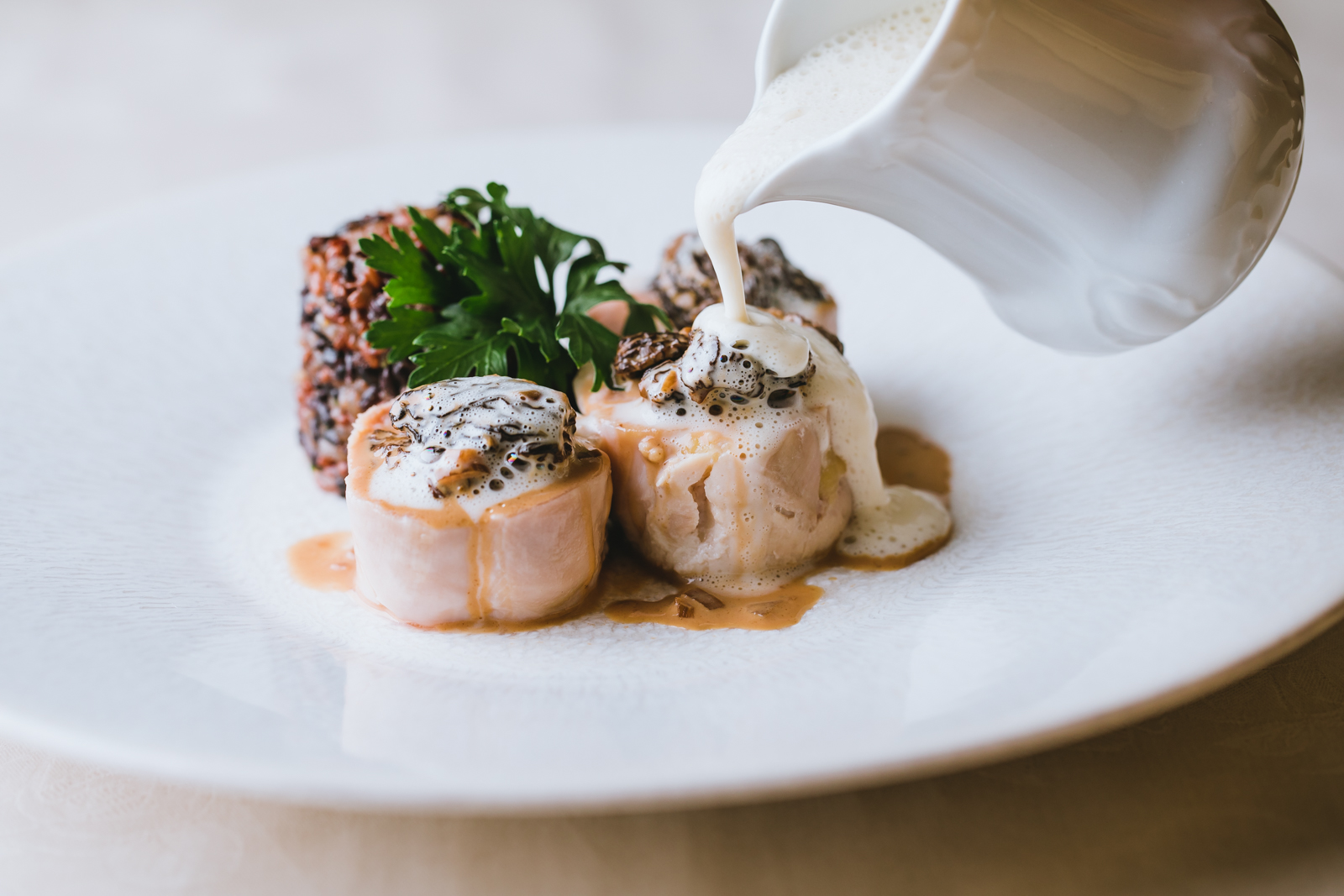
After seeing the customers' reactions to this dish, it struck me that the dishes from Jura have something attractive and intriguing, and that’s why we now serve it as a full portion for our main course. Moving it up from its original version of an appetizer.
Sommelière Yuko-san:
I made sure the dish of chicken and morel mushrooms was always paired with a Jura wine, and customers loved the pairing. Ma Poule quickly became the restaurant to savor wines of Jura.
Chef Tetsuya Ichioka:
Once we started offering Jura themed appetizers and other dishes. We started serving cheeses and wines from the region exclusively as well.
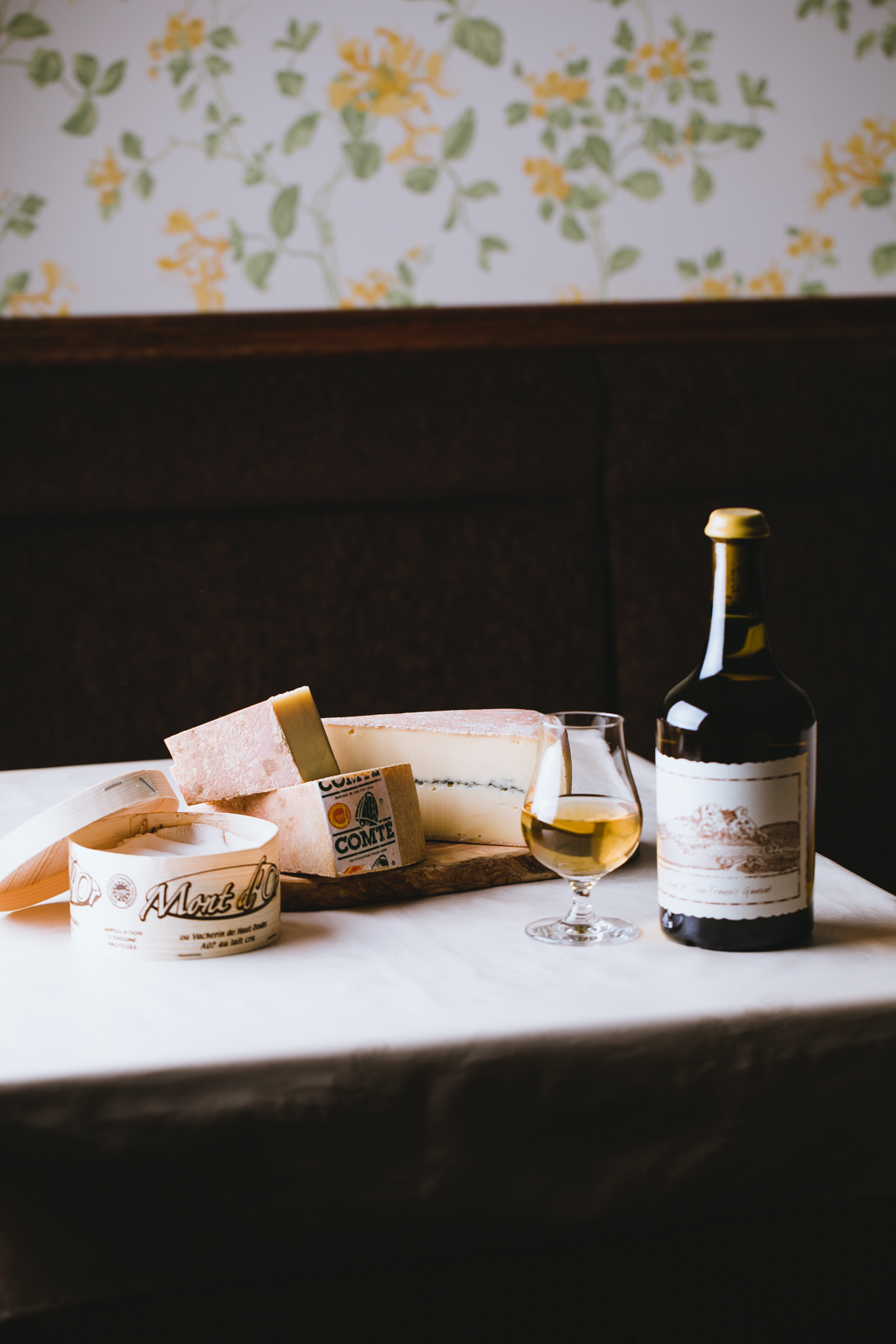
Interestingly, we didn’t force ourselves to make everything Jura. But, it was more like our guests started motivating us to do so. We were encouraged to unlock our passion for Jura’s culinary culture by our regular diners.
EATPIA:
What is it like to cook France’s regional cuisine in Tokyo these days?
Chef Tetsuya Ichioka:
I initially thought it was like going against the times. However, I had no intention at all to cook anything fitting of the times or, not to mention, trendy. I wanted to do what I was passionate about, not what I was simply capable of.
For me, the most important thing about cooking is to put your passion into the food you serve. It has nothing to do with using expensive ingredients or making dishes aesthetically attractive.
Sommelière Yuko-san:
You can say the same thing about wine. I like wines which you can taste the passion of the winemakers.
Chef Tetsuya Ichioka:
It doesn’t matter if it's food or wine, it’s cheap and tenuous if it’s not filled with passion.
French Cuisine
in France
EATPIA
You spent almost nine years in France. What did you learn from France? Did it impact the way you think and cook?
Chef Tetsuya Ichioka:
Japanese people use their tongues to sense taste. However, I think French not only use their tongue, but also their palate. I noticed the French tend to slightly look up when they drink wine. By doing that, they let not only their palate taste the wine, but also let their nose sense the aromas.
I think, while Japanese people sense tastes and aromas separately, French sense them together. This explains why they use spices and herbs abundantly when they cook. I thoroughly enjoyed using different types of local herbs I could find in the mountains when I was cooking in Jura.
Sommelière Yuko-san:
Every time I explain to our diners about herbs and spices the Chef uses, they get surprised. They seem to not notice them because the Chef doesn’t use them to accentuate or spice up the taste.
Chef Tetsuya Ichioka:
There’s a French term, ‘cuisine rond’. Which translates to, ‘round cuisine’. This however has nothing to do with the shape of the dish or food plating, but food which is well balanced (well rounded). Without one flavor being overpowering, but layers of tastes and flavors giving a depth to the overall impression of the dish.
This concept is something I wouldn’t have learnt if I didn’t go to France.
I still treasure my experience of cooking French food to French people in France.
Unique Air
EATPIA:
In addition to Jura, you have worked in Burgundy. You were the chef of a restaurant there for five years. I assume it was a very responsible position. Looking back on those years, do you think it was long or short?
Chef Tetsuya Ichioka:
It was both long and short. But if I had to choose one, I’d say long. I went through a lot in that time. However, I thoroughly enjoyed cooking and talking with the diners as the chef.
EATPIA:
Yuko-san, in Burgundy you worked as a sommelier with the chef for five years. What was most memorable?
Sommelière Yuko-san:
It was great to see firsthand how French people enjoy dining out. How they drink wine, and how they enjoy conversation. It’s very different from how we do in Japan.
It seems they find more value in dining out with family or friends than we do here. Drinking wine with a meal while enjoying conversation is something different from merely eating, drinking and eating. It is something very important in their lives.

On my days off, I used to dine with my friends and their family. I experienced the same thing I witnessed while working. I really think this experience is contributing to Ma Poule’s atmosphere, even though I am not sure if I’m doing anything special.
EATPIA:
Every time I come here I notice people are enjoying their dinner at their own pace. They seem to like the way time flows here.
Chef Tetsuya Ichioka:
We don’t know how specifically we are creating the atmosphere, but one thing for sure, that our guests sense the unique air of our small restaurant. I hope they can sense it’s operated by a couple who have spent time in France. If it wasn’t a small, it would get diluted.
Sommelière Yuko-san:
Among our guests are people who used to live in France, or are very knowledgeable about French culinary culture. They often say, “It feels like we are in the French countryside” or “It doesn’t feel like Tokyo anymore.” Every time I hear something like this, I assume our experience is helping the atmosphere of the place.
EATPIA:
Yeah, people dining here seem to be very passionate about French food, and familiar with French culture in general.
Sommelière Yuko-san:
They often study about Jura and its food and wine before they come. And, some of them come a long way to Todaimae.
Chef Tetsuya Ichioka:
They are serious dinners. Some come with very high expectations.
Getting Back
to The Basics
EATPIA
Four years have passed since opening, and in that time is there anything you’ve noticed that has changed in terms of French food?
Sommelière Yuko-san:
I think the number of young Japanese cuisiniers interested in traditional French food or France’s regional cuisine is increasing.
Chef Tetsuya Ichioka:
There might be something like a back-to-the-roots movement. Interestingly, those young cuisiniers usually come here and eat alone. However, many don’t look so confident for some reason. I’m concerned they don’t seem to enjoy cooking French food.
Sommelière Yuko-san:
I have asked them if they were a cuisinier or working at French restaurant. I remember a young cuisinier answered, “I’m working at a so-called French restaurant. But, I’m not sure if it’s authentic French food.”
Chef Tetsuya Ichioka:
They are probably working at restaurants serving a new type of French cuisine called, ‘innovative’. As a matter of fact, it doesn’t matter what type of food they are cooking, if they are ambitious and keep doing what they are doing with passion, they will eventually accomplish something special.
Future of French Food
EATPIA:
How do you think French food in Tokyo will evolve?
Chef Tetsuya Ichioka:
It will be divided into two types, traditional French cuisine, and its counterpart the new innovative type of cuisine.
Sommelière Yuko-san:
It seems people used to blend the two, traditional and innovative. They called both of them French. However recently, the media has started talking about them separately, as if they are two subcategories of the broad category of French food.
Chef Tetsuya Ichioka:
When you talk about France’s regional cuisines, you have to know the cuisine in Jura is completely different from the one in Basque. It would be very helpful if the media started talking more clearly about the regionality of France, just like they do when they talk about wines.
If you know specifically what kind of French food you would like to eat, you would more likely find a good restaurant. It doesn’t matter if it is regional cuisine or innovative cuisine, you have to know clearly what kind of food you would like to eat.
Sommelière Yuko-san:
By the way, now I remember I noticed when I was in France, French people tend to care less about what’s fashionable or in trend. Instead, they seem to enjoy adapting things they like to their lives, regardless of what other people think.
With Ma Poule, I would like to keep doing things we think are right, and aim to attract people who understand what we do.
EATPIA:
Thank you very much for talking with me. This will probably be our longest interview article to date.
English text edited by Craig Atkinson.

For more about Ma Poule, please follow the link below.
https://www.eatpia.com/restaurant/Ma-Poule-Todaimae-French

If you are interested in reading any of our previous interviews, you can also find them at the link below!













